When it comes to mine safety, ladders don’t always get the attention they deserve—but they should. Whether workers are climbing into confined spaces or accessing elevated work areas, ladders are a part of daily life in both surface and underground mining. That constant use means wear and tear is inevitable, and without the right precautions, ladders can quickly become a serious safety risk. Keeping ladders safe and reliable for miners isn’t just about ticking off inspection boxes—it’s about preventing falls, injuries, and costly downtime. This guide takes a practical look at how to meet MSHA standards for fixed ladders, avoid common hazards, and build a strong safety culture from the ground up—starting with smarter ladder use and maintenance.
Why Ladder Safety Should Be a Daily Priority in Mining Operations
Ladder safety in mining isn’t something to check off once—it’s an ongoing commitment. Every day, miners climb ladders to access equipment, service remote areas, and reach escape routes. Each of these moments carries risk if ladders are unstable, poorly maintained, or incorrectly used. That’s why ladder safety must be part of every shift briefing and site inspection. Accidents involving ladders often result in serious injuries, lost productivity, and preventable downtime. Building awareness around safe ladder use not only keeps miners safe but reinforces a culture of responsibility and vigilance on-site.
Identifying Common Ladder Hazards in Surface and Underground Mines
Both surface and underground mines pose unique challenges when it comes to ladder use. In surface mines, ladders are often used around mobile equipment and steep terrain, creating fall risks due to vibration, dust, and uneven ground. Underground hazards include poor lighting, slick surfaces, confined spaces, and exposure to water or chemicals. Common issues like damaged rungs, missing bolts, corroded materials, or unstable anchoring can quickly turn a routine task into a dangerous one. Recognizing these dangers requires ongoing training and attention from every crew member.
Choosing the Right Ladder for Specific Mining Tasks
Not all ladders are created equal. Using the wrong type of ladder for a job—such as a portable ladder for tasks that require fixed access—can lead to preventable falls. When selecting a ladder, factors like load rating, material (e.g., aluminum, fiberglass), resistance to environmental elements, and rung type must all be considered. For electrical work, non-conductive fiberglass ladders are essential. For wet or chemical-heavy environments, corrosion-resistant coatings or materials help preserve strength and traction. Choosing the right ladder starts with understanding the task and environment clearly.
Ladder Stability and Slip Prevention on Uneven or Sloped Surfaces
Mines rarely offer flat, stable ground. Sloped terrain, gravel, and mud are common, which makes securing ladders an important step before climbing. Fixed ladders must be anchored to solid structures and extend fully above landings for stability. For portable ladders, using slip-resistant feet, proper angles (about 75 degrees), and avoiding use on uneven ground without leveling support is key. Anti-slip rung covers and regular cleaning also improve traction and prevent slips caused by oil, grease, or mud.
Understanding MSHA Standards for Fixed Ladders: What Every Miner Needs to Know
The Mine Safety and Health Administration (MSHA) requires all fixed ladders to meet specific design and maintenance standards under Parts 56 and 57 of the Code of Federal Regulations. These rules include minimum rung spacing, ladder length requirements, and safety devices such as cages or lifelines for climbs over 20 feet. MSHA also mandates that ladders in escape routes remain unobstructed and well-lit, supporting quick evacuation during emergencies. Violations of these standards not only risk fines but put lives in danger. Every miner should know these basics to help identify hazards and report violations.
How to Train Mine Workers for Ladder Competency and Safe Use
Training is the foundation of safe ladder use. Workers must understand not just how to climb a ladder, but how to assess whether it’s safe to use in the first place. Competency training should cover identifying defects, setting proper angles for portable ladders, using fall protection correctly, and reporting unsafe conditions. Refresher courses and site-specific briefings ensure that ladder safety stays top-of-mind. Supervisors play a key role in reinforcing safe practices through consistent feedback and modeling correct behavior.
Daily and Weekly Ladder Inspection Checklists
Routine inspections are one of the most effective ways to catch hazards early. Each day, miners should check ladders for visible damage: cracks, loose bolts, worn rungs, or slippery surfaces. Weekly inspections should go deeper—checking anchoring, rung spacing, corrosion, and alignment. Records of these inspections should be documented, and any damaged ladders should be removed from service immediately. Keeping ladders safe and reliable for miners starts with these regular checks.
Best Practices for On-Site Maintenance of Ladders
Maintenance ensures that ladders remain in good condition long after installation. This includes:
- cleaning mud or debris from rungs
- tightening bolts
- lubricating moving parts, and
- applying anti-slip coatings.
In mines with high humidity or chemical exposure, more frequent maintenance may be needed. Paint or rust may cover serious cracks, so be cautious when inspecting older ladders. Always follow manufacturer recommendations and MSHA requirements for ladder upkeep.

How to Handle and Report Ladder Incidents and Near Misses According to MSHA Standards
When a ladder-related incident occurs—even a near miss—it must be taken seriously. MSHA requires that serious injuries and fatalities be reported within 15 minutes. However, near misses should also be documented and investigated to prevent future accidents. Develop a clear reporting process that encourages transparency without blame. Investigations should look beyond user error and consider equipment design, maintenance, training, and environmental factors. Sharing lessons learned across crews can prevent similar incidents elsewhere.
Keeping Miners Safe Starts from the Ground Up
Keeping ladders safe and reliable for miners is about more than equipment—it’s about culture, training, and daily commitment. From purchasing the right ladder to regular inspections and reporting, each step matters. MSHA provides the baseline, but it’s up to mine operators and crews to go beyond compliance. Safer ladders mean safer miners. And safety, in the mining industry, is the most valuable resource of all.

